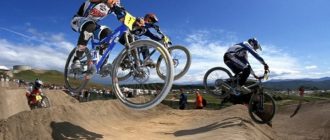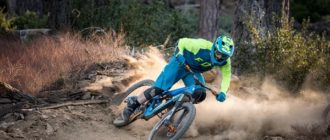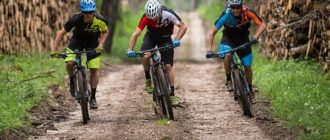Uphill is a cycling sport that involves climbing up a mountain or hill at high speed. It is one of the safest mountain biking disciplines, but it is not suitable for beginners because it requires serious physical training to compete.
History of origin
German, Baron Carl von Drez back in 1817 designed the first prototype of a bicycle. It was a real two-wheeled scooter, which the inventor himself called “a machine for running” – a dresina. Its frame, tires and handlebars were made of wood. People rode the dresina by pushing off the ground with their feet, since it had no pedals.
Over the years, Drez’s invention improved: the frame was made of metal, pedals and a saddle were added. But it wasn’t until 1884 that the vehicle that most resembled modern bikes appeared.
And if the first bikes could only ride on level roads, then as they improved among cyclists appeared willing to overcome obstacles and conquer mountains. Especially for these extreme bikes began to “outfit” shock absorbers, a wide range of gears, wide wheels – so mountain biking was born.
As a sports discipline, mountain biking is already 30 years old – in 1990 the first world championship was held on mountain biking. Since then, mountain biking has been held regularly.
Uphill is one of the 10 mountain biking disciplines. The terrain used for Uphill—how-to-learn–tips competitions is either dirt or asphalt. The start is as a single, and group, the orientation of the track – all the time Uphill—how-to-learn–tips. Competition organizers determine the complexity of the route and its length.
To take part in the Uphill—how-to-learn–tips, apart from good physical preparation and endurance, you need a lightweight bike (no more than 10 kg) and the lack of excess weight in the athlete. To reduce the weight of equipment, participants do not even wear protective accessories. Given that during the competition you will need to pedal almost constantly in a pulling climb, the less weight you have to carry, the less effort will be spent on the climb.
What you need for a fast climb
There are specific climbing elements that will need to be practiced in order to get Uphill—how-to-learn–tips fast in competition and still conserve energy as much as possible:
- Breathe correctly: either by revolutions of two pedals (inhale for two revolutions and exhale for the next two revolutions), or by revolutions of one pedal (turn right – took a breath, turn left pedal – took an exhale). It is important that your breathing be even.
- Spin the pedals, don’t push them. Keep your knees close to the bike frame. You can learn spinning technique – to use it you need special contact pedals or fixing platforms.
- Do not rush, as well as too slow, climb smoothly, save the pace.
- Leaning to the steering wheel, while maintaining a sitting position.
- Reduce the gear to 70-90 rpm.
- Climb longitudinally – this will help reduce the load. It may increase the radius of ascent, but this way will save you a lot of energy.
- You can do the last meters before the finish line standing up to increase the power of ascent, but stay seated for the rest of the competition.
- You can also increase your climbing power by increasing your gear.
- Increase the traction of the rear wheel by “hooked” rubber.
- Remove the rear suspension and use shock absorbers on the front fork.
- Make sure the sprocket has at least 28 teeth.
- Lighten up your bike as much as possible: get on a bike with a lightweight aluminum frame, take a minimum of equipment and lose weight if you are overweight.
Recommendations
Given that it is – a competition for high-speed climbing Uphill—how-to-learn–tips, you should choose a special modified mountain bike – cross country mountain bike. Wheels should be 26 inches in diameter, up to 29. Rubber, which will increase the grip on the pavement – off-road “toothy.
Optimal design – hardtail or two-pods with a shock-absorbing fork. The first is better to use when riding on a flat surface – it quickly picks up speed at the start, with it there is no rocking when actively pedaling, it is lighter in weight and cheaper than a two-saddle.
But if you have to ride on rough terrain, then it’s better to use a two-pod. With it, your rear wheel will not lose contact with the surface of the track, as it can happen with a hardtail if your bike collides with the slightest obstacle. A two-pod increases speed over difficult terrain and is easier to handle over bumps and bumps, saving you time in the race.
Conclusion
To feel like a mountain climber, the Uphill—how-to-learn–tips is one of the best options. By competing against other athletes in strength, endurance and speed, you get a great boost of energy and self-confidence. And to make victory a reality, train regularly in Uphill—how-to-learn–tips cycling. Gradually your body will adapt to the strain, you will gain experience and you will develop your riding style in this sport.









This is a great post! I’m always looking for ways to learn more effectively, and the tips here are really helpful. Thanks for writing this!